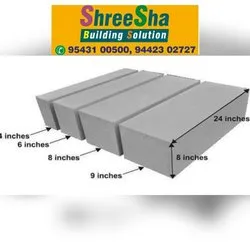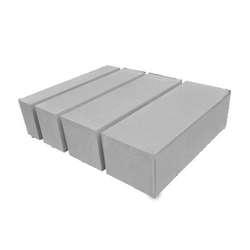Aac Siporex Block Light Weight
₹43.0
| Country of Origin | Made in India |
| Size | 24x8x3 |
| Material | Autoclaved Aerated Concrete |
| Brand | siporex |
| Coverage Area | 1.32sq |
| Usage/Application | Roof |
Siporex blocks are lightweight, pre-cast AAC blocks that are used in construction projects that require superior thermal insulation and heat-resistance. They are also referred to as cellular concrete.
- Description
- Additional information
- Reviews (0)
- Q & A
- Sustainability Remark
- More Offers
- Store Policies
- Inquiries
| brands | siporex |
|---|---|
| Size | 24x8x3 |
You must be logged in to post a review.
Q & A
Renewable Material Cellular Lightweight Concrete (CLC) is considered a sustainable building material due to several reasons:
Renewable materials: CLC is typically made from a combination of renewable resources such as cement, fly ash, and water. These materials can be sourced locally, reducing the need for transportation and associated carbon emissions.
Energy efficiency: The manufacturing process of CLC requires less energy compared to traditional concrete. It involves the use of foaming agents or preformed foam, which creates air bubbles in the mixture, reducing the overall density of the concrete. This results in lower energy consumption during production and transportation.
Reduced carbon emissions: CLC has a lower carbon footprint compared to conventional concrete. The use of fly ash, a byproduct of coal-fired power plants, as a partial replacement for cement in CLC reduces the demand for cement production. Cement production is known to be a significant source of carbon dioxide emissions.
Thermal insulation properties: CLC has excellent thermal insulation properties, which can contribute to energy savings in buildings. The lower density and air-filled voids in the concrete reduce heat transfer, thereby reducing the need for artificial cooling and heating, leading to lower energy consumption.
Lightweight construction: CLC is lighter in weight compared to conventional concrete, which can lead to savings in structural materials and transportation costs. This can result in a reduction in embodied energy and lower environmental impacts associated with the construction process.
Waste reduction: CLC can utilize industrial byproducts such as fly ash or recycled materials, reducing the amount of waste sent to landfills. Additionally, the use of foam to create air pockets in the concrete can help to consume less raw material.
However, it's important to note that the sustainability of CLC depends on various factors such as the sourcing of materials, manufacturing practices, and transportation distances. To maximize the sustainability of CLC, it is crucial to consider the entire lifecycle of the material, including its production, use, and disposal, and to adopt best practices that minimize environmental impacts.
General Inquiries
There are no inquiries yet.





Reviews
There are no reviews yet.